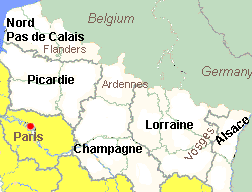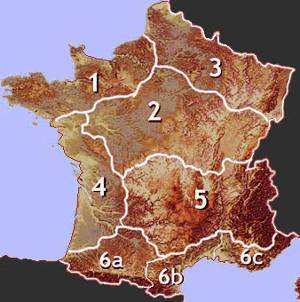
Gites in Alsace and Lorraine
Self catering in Alsace & Lorraine, including the Vosges mountains - 2026
 Sector
3c . North east France
Sector
3c . North east France
Alsace & Lorraine areas
Includes the following French departments: comprend les départements...
Lorraine (capital Metz) : 54 Meurthe et Moselle, 55 Meuse, 57 Moselle; Alsace (capital Strasbourg) : 67 Bas Rhin, 68 Haut Rhin, 88 Vosges.
Key 🏠 Book directly with the owners / Réservation directe
Website in English Site en français
Website auf deutsch Website in Nederlands
Gites in Alsace and Lorraine
- Alsace vineyards 67 🏠 Village gite for up to ten people in the Alsace vineyard area between Strasbourg and Colmar. Four bedrooms, two bathrooms. Gîte dans un village du vignoble alsacien entre Strasbourg et Colmar. Quatre chambres, deux salles d'eau, terrasse, wifi, parking gratuit.
- Alsace, Hohwald 67 Chalet gite and bed and breakfast in this Alsace mountain village. Free parking, wifi, balconies and or private terrace. For B&B customers full English breakfast. Chalet/gite et appartements et chambres d'hôtes chez Tilly, dans le village du Hochwald, dans la montagne alsacienne. Parking gratuit, wifi, balcon ou terrasse privative. Pour clients chambres d'hôtes, petit déjeuner à l'anglaise.
- Two
gites for 4 near Strasbourg. 67
 +
In a typical Alsace village 18 miles from Strasbourg, two gites for 4
or 5 adults in an 18th century farmhouse - terrace, large
gardens. A
quelques encablures de Sttrasbourg, dans un village typiquement
alsacien, deux gites pour 4 ou 5 personnes dans une ferme du 18e
siècle..
+
In a typical Alsace village 18 miles from Strasbourg, two gites for 4
or 5 adults in an 18th century farmhouse - terrace, large
gardens. A
quelques encablures de Sttrasbourg, dans un village typiquement
alsacien, deux gites pour 4 ou 5 personnes dans une ferme du 18e
siècle.. - Alsace
gite near Switzerland. 67
 +
Close to the Swiss border, Alsace village gite with three bedrooms,
sleeps 6. Garden, bikes available. Wifi. A
quelques kilometres de la frontière suisse, gite dans un village
alsacien. Trois chambres, jardin, BBQ. Pour jusqu'à six
personnes. Vélos disponibles.
+
Close to the Swiss border, Alsace village gite with three bedrooms,
sleeps 6. Garden, bikes available. Wifi. A
quelques kilometres de la frontière suisse, gite dans un village
alsacien. Trois chambres, jardin, BBQ. Pour jusqu'à six
personnes. Vélos disponibles. - BandB in the Moselle 57 30 km southeast of Metz, in the heart of the countryside, B and B accommodation with five ensuite guest rooms. Free wifi, and landscaped gardens. Kitchenette available for guest use. A 30 km au sud-est de Metz, à la campagne, chambres d'hôtes avec salles de bains. Wifi gratuit, jardin paysager, et coin cuisine à la disposition des hôtes.
| Nord and Picardy | Champagne | Gitelink home |  En français En français |
Depending on the gite, booking is either direct with the owners, or through our partner booking.com ; in either case, you will normally pay the gite owners directly. You may need to give a credit card number to secure your booking, even if full payment is not due until later .
| Owners:
Adding your gite to Gitelink : Gitelink is a cost-effective way of showcasing gites villas and cottage accommodation to a targeted audience on Internet |
Propriétaires: Ajouter votre site sur Gitelink : L'annuaire Gitelink peut être une vitrine internationale pour votre gite. Pour plus d'informations, consultez la page propriétaires. |
| The Gitelink France directory lists selected self-catering holiday gites in France. Each site listed is the individual responsibility of the owner of the property, and contains a detailed and illustrated presentation of the gite and - in many cases - of the area in which it is situated. | |
Copyright Gitelink.com - 2024
Photo top of page from an original by Trubble - Creative commons 2.0 licence
Photo top of page from an original by Trubble - Creative commons 2.0 licence
► Return to Gites in France
A selection of
self-catering holiday cottages for hire directly from the owners.
Best rates, no extra
fees !
For most properties listed on Gitelink, owners take direct bookings,
sparing you
the commissions and fees
charged by many online holiday rental agencies. For some properties,
including most in this area, owners use a
booking service that does not charge any extra fees to the visitor. As
an affiliate partner, Gitelink may receive a small commission on
bookings, but this will not affect the price. The Gitelink selection
The Gitelink selectionAlsace and Lorraine
Part of the Great Eastern region of France, Alsace and Lorraine are two areas that have been deeply marked by Germanic culture. Indeed until the twentieth century, German - in the form of local Germanic dialects - was the first language throughout Alsace, and in parts of Lorraine. Along with the Netherlands, Belgium, Luxembourg and Switzerland, Alsace and Lorraine make up the historic central band of western Europe, once the Emperor Charlemagne's central kingdom, between France to the west and Germania to the east.The areas' culture, architectural styles, and traditions in wine and food are heavily marked by their historic heritage - most markedly so in Alsace. As part of the Rhine valley corridor, Alsace has always been culturally and to a certain extent economically attached to its German neighbour.
The two areas are separated by the chain of the Vosges mountains. To the east, and including the upper part of the Moselle valley, Lorraine is a land of farming communities, woodland and in the Vosges area spruce forests. The northern part of the region, the north of the Moselle department, was once a major coal-mining area; but this industry closed down many years ago. The south and west of Lorraine is very rural, with the Vosges department having much in common with Germany's Black Forest, less than 100 km to the east. Lorraine contains two historic European cities, Nancy and Metz.
Alsace occupies the eastern slopes of the Vosges, at the foot of which lie the famous Alsace vineyards. Strasbourg, the Alsace capital, is a very attractive historic city, as well as being the seat of the European parliament; the Alsace plain is dotted with a lot of very pretty villages, with their brightly painted half-timbered houses in the Germanic tradition. In south Alsace, Colmar is a fine historic city, while the nearby city of Mulhouse boasts France's national railway museum.
Getting to Alsace & Lorraine
Driving times
By
road:
from Calais or Lille: The whole area is easily accessible via the A26
and A4 motorways from Calais, or by many routes from Belgium. Both
Alsace and Lorraine have direct access from Germany. Alsace also
borders Switzerland.See Driving in France
Access by rail
Access by rail: TGV from Paris Gare de l'Est or from GermanyFly out
Regional airport: Strasbourg,
Basel-MulhousePeripheral airports: Luxembourg, Karlsruhe, Zurich
Gites in other regions -
clickable map

